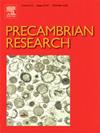TTG petrogenesis and U–Pb SHRIMP zircon geochronology constraints on the tectonic regime and formation of the Mesoarchean crust from the Ourilândia–Tucumã area in the Carajás Province, Amazonian Craton, Brazil
IF 3.2
2区 地球科学
Q2 GEOSCIENCES, MULTIDISCIPLINARY
引用次数: 0
Abstract
Tonalite–trondhjemite–granodiorite (TTG) magmatism marked crucial episodes in early crustal growth and cratonization worldwide; petrogenetic processes, tectonic configurations, and sources of TTGs are the focus of continuous debate. Here, we present a geochemical and geochronological (zircon U–Pb SHRIMP) study of TTG granitoids to determine their petrogenesis and to better constrain the crustal evolution of Carajás Province. New evidence of preserved TTG crust in the Ourilândia–Tucumã area, which is composed of tonalite–trondhjemites, is presented. The tonalite has an emplacement age of 3.0 Ga. These rocks are consistent with low- and medium- to high-pressure TTGs. Our modeling of the sources that gave rise to these TTGs revealed that the origin of the trondhjemites was related to the 13 % partial melting of an amphibolite/eclogite source at high pressure (approximately 1.5 GPa) in the garnet/rutile stability zone. The tonalite data also suggest 16–22 % partial melting of a metabasaltic crust at medium–low pressures (approximately 1.0 GPa), with little or no influence from garnet in the residue. The source had an affinity with the metabasalts in the greenstone belt sequence of the Tucumã–Gradaús Group. The proposed geodynamic setting of the Carajás Province TTG crust evolved from stagnant lid tectonics to mobile lid tectonics. Drip tectonics occurred over 30–50 Ma, aborted low-angle subduction began to occur, and as the crust became thicker and more resistant, increasingly steep subduction occurred.
巴西亚马逊河克拉通Carajás省Ourilândia-Tucumã地区TTG岩石成因和U-Pb SHRIMP锆石年代学对中太古代地壳构造制度和形成的制约
闪长岩-闪长岩-花岗闪长岩(TTG)岩浆作用标志着世界范围内早期地壳生长和克拉通化的关键时期;成岩过程、构造构造和ttg的来源一直是人们争论的焦点。在此,我们对TTG花岗岩类进行了地球化学和年代学(锆石U-Pb SHRIMP)研究,以确定其岩石成因,并更好地约束Carajás省的地壳演化。提出了在Ourilândia-Tucumã地区保存的由闪长岩组成的TTG地壳的新证据。该调晶石的就位年龄为3.0 Ga。这些岩石与低、中、高压ttg相一致。我们对这些ttg成因的建模表明,闪辉石的起源与石榴石/金红石稳定带高压(约1.5 GPa)下角闪岩/榴辉岩源13%的部分熔融有关。晶长岩数据还表明,在中低压(约1.0 GPa)下,变质玄岩地壳有16 - 22%的部分熔融,残留的石榴石很少或没有影响。烃源岩与Tucumã-Gradaús群绿岩带层序中的变质玄武岩有亲缘关系。提出Carajás省TTG地壳动力学背景由静止盖构造演化为活动盖构造。在30-50 Ma期间,发生了滴漏构造,开始发生流产的低角度俯冲,随着地壳变厚和抵抗力的增强,发生了越来越陡的俯冲。
本文章由计算机程序翻译,如有差异,请以英文原文为准。
求助全文
约1分钟内获得全文
求助全文
来源期刊

Precambrian Research
地学-地球科学综合
CiteScore
7.20
自引率
28.90%
发文量
325
审稿时长
12 months
期刊介绍:
Precambrian Research publishes studies on all aspects of the early stages of the composition, structure and evolution of the Earth and its planetary neighbours. With a focus on process-oriented and comparative studies, it covers, but is not restricted to, subjects such as:
(1) Chemical, biological, biochemical and cosmochemical evolution; the origin of life; the evolution of the oceans and atmosphere; the early fossil record; palaeobiology;
(2) Geochronology and isotope and elemental geochemistry;
(3) Precambrian mineral deposits;
(4) Geophysical aspects of the early Earth and Precambrian terrains;
(5) Nature, formation and evolution of the Precambrian lithosphere and mantle including magmatic, depositional, metamorphic and tectonic processes.
In addition, the editors particularly welcome integrated process-oriented studies that involve a combination of the above fields and comparative studies that demonstrate the effect of Precambrian evolution on Phanerozoic earth system processes.
Regional and localised studies of Precambrian phenomena are considered appropriate only when the detail and quality allow illustration of a wider process, or when significant gaps in basic knowledge of a particular area can be filled.
 求助内容:
求助内容: 应助结果提醒方式:
应助结果提醒方式:


